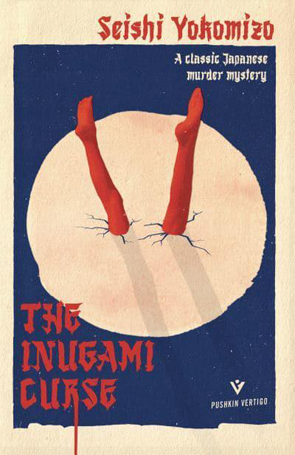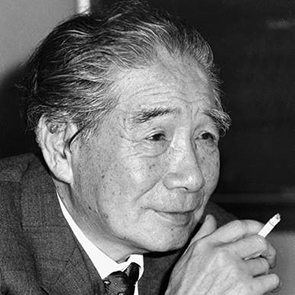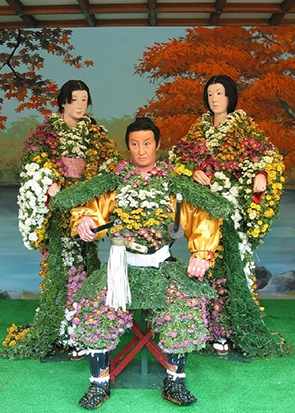“Detective you have to arrest her. You have to arrest her and put her to death. Not just the regular death penalty – that’s not good enough for her. I want her to hang by her heels, rip her to shreds, burn her till she’s black, and pull out her hair, strand by strand.”
- One family member accusing another after the third murder, in The Inugami Curse. (There’s not much affection between anyone in this family!)
This is the second of Seishi Yokomizo mysteries to be translated into English. These English translations, published by Pushkin Vertigo, are changing the order slightly from the original order. In the original Japanese publication, this is the sixth Kosuke Kondaichi mystery. The next one in the English translations is the fourth in the Japanese series, so they are really jumping around.
This book has a very different feel to The Honjin Murders, the first Kondaichi book. The Honjin Murders was very much a locked room mystery in the classic Golden Age tradition, with the whole thing solved within a few days. This one, in contrast, takes place over several months, with new murders popping up at regular intervals. The writing style is also different. This one uses a more standard omniscient narrative, without the device of a writer explaining the book he is writing about, as was done in the plot that Yokomizo used in The Honjin Murders. There is also no breaking of the fourth wall to explain how he structured the plot to conceal the murderer and deceived us.
The book is set sometime in the 1940s, just after the end of World War Two. Sahei Inugami dies of natural causes in the opening pages. He is eighty-one, the extremely wealthy and powerful head of the Inugami clan. His family are eager for Sahei’s will to be read, but find they are forced to wait until the eldest grandchild, Kiyo, returns from the war, as dictated by the terms of the will. Kiyo is being held in Burma and no one is sure when he will be repatriated to Japan. He finally returns around nine months later, and the will is read. Its terms are rather bizarre, and this sets everyone in the family even more against each other than they already were.
The family is a strange one, as Sahei never married, but rather kept three mistresses in his house at the same time, fathering a daughter with each of them. Each daughter has one son, each of whom expects to inherit at least part of the family fortune. Kiyo, the eldest grandson, is expected to inherit the bulk of the fortune, and the family silk business. But instead, Sahei leaves all of his fortune to Tamayo, the orphaned granddaughter of his former mentor, Daini Nonomiya, the priest at the local Shinto temple, on the condition that Tamayo choose one of the grandsons to be her husband within three months of the reading of the will. If she refuses to marry any of them, or dies within the three months, the bulk of the fortune is to pass to another person completely, Shizuma Aonuma. Shizuma turns out to be Sahei’s unacknowledged illegitimate son from a fourth mistress, unseen in the district since his mother fled with him when he was a baby. It’s all a big mess, with each branch of the family competing against each other branch for control. And this brief description doesn’t even touch on all the plot complications: it gets way weirder, especially after the murders start. Greed and position inside the family are the major motivators for almost everyone, and not many of them have any affection for any of the others. The three sisters, in particular, all hate each other, snapping away at each other with vitriol. There is fresh revelation after revelation as this twisted family soap opera unfolds. As the family lawyer observes about the will, “It will be like hurling the remaining members of the Inugami clan into a maelstrom of conflict, kin against kin.”
The murders themselves are bizarre, and unlike any I can remember in any other mystery. For example, one of the early murders results in the victim being beheaded, the body dumped in the nearby lake and the head switched with the head of a chrysanthemum doll. Gradually, the family realises that the murders (there are other murders as well) represent the three sacred objects of the Inugami clan, the ax (yoki), the zither (koto) and the chrysanthemum (kiku). The significance of these objects is that when the words are spoken together, yokikotokiku, they are homonymous with ‘we hear good tidings’, the family motto. This blessing ironically becomes the titular family curse.
Watching all the action unfold but unable to prevent the murders from piling up is our detective, Kondaichi. He was fairly unknown in the first book, but by now he has established a good reputation and the local police are happy for him to be involved in every step of the investigation, which is baffling them. It takes him some time to figure out what is going on, but eventually his mind connects a number of seemingly unimportant events.
This is a very twisted but clever plot that rapidly becomes addictive to read. Everyone has a motive, there are side plots galore and red herrings scattered about at regular intervals. But Yokomizo keeps everything under control and manages to tie up all of the loose ends by the conclusion and unmask the murderer.
This is highly recommended and I’m looking forward to reading the recently released third instalment of this series.
 RSS Feed
RSS Feed Facebook
Facebook Instagram
Instagram YouTube
YouTube Subscribe to our Newsletter
Subscribe to our Newsletter





No one has commented yet. Be the first!